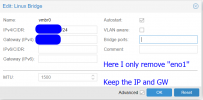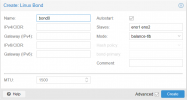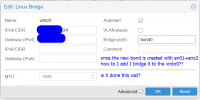Last edited:
You mean I only have to remove the "eno1" from → vmbr0 then create a bond# with both → eno1+eno2 then bridge the new bond# to the vmbr0.You can remove eno1 from vmbr0, create a bond using eno1 + eno2 and bridge that bond to vmbr0 (vmbr0 can keep the same gateway/IP) and hit "apply". But make sure you got a WebKVM or keyboard+monitor attached to the server in case something goes wrong.



Yes that should work. If PVE is complaining you might need to remove the vmbr0 completely and add it again after creating the bond. But that also should be fine as long as you only click the "apply" button at the very end. IF you want to be able to restore that config using CLI you could create a copy of your /etc/network/interfaces (You mean I only have to remove the "eno1" from → vmbr0 then create a bond# with both → eno1+eno2 then bridge the new bond# to the vmbr0.
Have you done that, if yes, did it worked for you? and all this can be done within the Web Interface?
Action Steps:
1st Step:
View attachment 30315
2nd Step:
View attachment 30316
End: will it be done this way?
View attachment 30317
I am trying to understand how to do it in CLI in case if I lost access!
Thank you so much.
cp /etc/network/interfaces /etc/network/interfaces.backup) so if something won't work you can restore your network config.That is what I did. but did not use it. all went wellYes that should work. If PVE is complaining you might need to remove the vmbr0 completely and add it again after creating the bond. But that also should be fine as long as you only click the "apply" button at the very end. IF you want to be able to restore that config using CLI you could create a copy of your /etc/network/interfaces (cp /etc/network/interfaces /etc/network/interfaces.backup) so if something won't work you can restore your network config.

We use essential cookies to make this site work, and optional cookies to enhance your experience.

